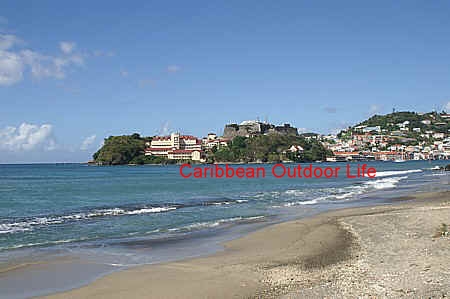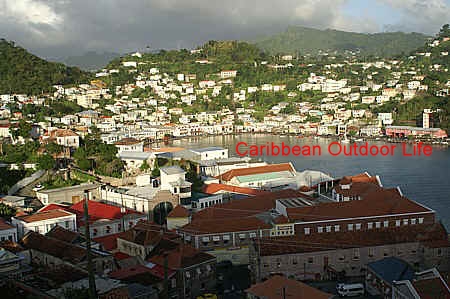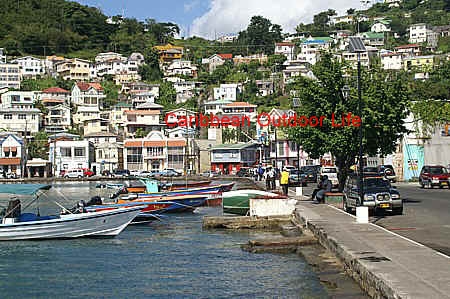|
If you are in Grenada and thinking of doing
some sightseeing, there are an abundance of places of interest to visit. This Caribbean
holiday destination has several historic forts, functional old style rum distilleries,
working cocoa and spice estates plus museums, gardens, lakes, waterfalls and springs.
Below are some of the places of interest that you will enjoy visiting while on your
Grenada vacation.
Grenada National Museum
The Grenada National Museum is located off Young Street in St Georges, near to the Carenage. This small but interesting museum offers a fine
collection of objects and artifacts of the island's history and culture. Even the building
in which the museum is housed is historical as it is set in the foundations of an old army
barracks and prisons built in 1704. The Museum building was also the first
hotel in Grenada.
Rome’s Museum
This is not your normal museum of dry historical facts and figures, rather it is a
showcase of how the average person lived in Grenada 50 years ago. The museum is small but
definitely one of the places of interest. Located in the small area of Walker, the museum
is a creation of Mr. Rome. Walker is approximately 2 miles from Mount Carmel, which is near Tuilleries.
The Carriacou Museum
The Carriacou Museum is housed in a restored cotton gin mill on Paterson Street. The
museum is managed by the Carriacou Historical Society and has Amerindian artefacts as well
as exhibits tracing the early British and French occupation of the islands. It also has an
African section.
Sendall
Tunnel
This seven feet tall tunnel was constructed in 1894 and still operates
today. It was drilled straight through the rocks of the hill on which Fort George stands
and provides a route to get from the Carenage to the other side of town. Still in use
today it is a busy thoroughfare for both pedestrians and vehicles.
Fort George

Rising above the northern end of the Carenage in St
Georges, this fort was built between 1706 and 1710 on top of earlier fortifications that
had been constructed by the French in the 1600’s. The fort continues to be in use
even today, housing parts of the Royal Grenada Police Force. This should definitely be on
your list of places to visit as it provides fantastic views of the Carenage
with the ships alongside the quay and the pastel coloured houses rising up the hills.
Fort Frederick
Fort Frederick is another of Grenada’s historic forts being built by the French
after their capture of Grenada from the British in 1779. The fort is on the hills above St
Georges and provides stunning views that make you feel that you can see all of Grenada
from its ramparts.
Government House
In 1790, this building located on upper Lucas Street was part of a compound
used to house soldiers. In 1804 the compound was abandoned however you can
still see the ruins of a battery.
The Tower St. Paul.
Located beyond the St. Paul Police Station in the Parish of St. George's,
the Tower represents one of the few old stone houses built of volcanic rock
in a Caribbean Colonial Style of Architecture. It was built in 1917 by a
prominent Grenadian Lawyer, C.F.P. Renwick, who constructed the house to
persuade his English wife to remain on the Island. Today the House functions
as a family home and is available for tours on an appointment basis. This
house sits on a scenic eleven acre property of spice and fruit trees, within
15 minutes of St George's.
Mount Hartman Dove Sanctuary
Grenada has a species of dove that is found nowhere else in the world. Called, quite
rightfully, the Grenada Dove (Leptotila wellsi) it is a protected species. The Mount
Hartman Sanctuary is a dry thorn scrub eco-system that provides the opportunity to observe
this dove and learn about it. The Sanctuary is located near Woburn Bay.
Belmont Estate
This is an opportunity to see a working cocoa estate plus learn of agricultural history
from the middle of the last century. Around the estate there are farming implements from
long ago such as an old hand-cranked whetstone that was used for sharpening cutlasses, old
steam equipment that was used in preparing the cocoa beans, the rolling sheds on which the
beans were dried. Inside one of the buildings are furniture, kitchen equipment, estate
ledgers, phone books, personal effects from the last century. This is still a working
cocoa estate so beans are still brought to be danced and there are still farm animals
around. The estate is in the northeast of the island between Grenville
and Levera, just below Tivoli
Dougladston Estate
Lying just outside Gouyave on the west
coast, the Dougladston Estate is another of Grenada’s working estates where you can
both get an agricultural history lesson and learn about the spices that have made Grenada
famous. Depending on the time of year, the estate processes mace, cinnamon, pimento,
cloves, nutmeg, tonka beans, sapote. Not only will you see the spices but you can learn
how they are reaped and processed plus what they are used for. If the wonderful aroma
makes you want to have some of the spices for yourself, you can purchase spices at the
estate. Dougladston Estate also processes cocoa so you will also learn about that
wonderful bean.
River Antoine Estate and Rum
Factory
One of the fascinating places to visit is the Grenada Rum Factory on the River Antoine
Estate, which provides guided tours. Rum has been manufactured here for almost 225 years.
The factory still uses a water wheel for pressing the sugar cane in a process that has not
changed for generations and the island’s only railway still operates for transporting
the sugar cane. The River Antoine Estate is in the north near to Lake
Antoine and not far from Tivoli.
Claboney Volcanic Hot Spring
Relaxing in the soothing water of a volcanic hot spring is a great way to relieve the
tensions of a stress filled life while on a Caribbean holiday. Grenada has several hot
springs that are a result of its volcanic origin. The Claboney hot spring in Grenville is one of the easier springs to get to as you can drive to
within a short distance of the spring and then walk about one hundred yards to the spring.
From St Georges you drive to Grenville via Grand
Etang and turn off on the road leading to Claboney. The pool of warm sulphur filled
water is about 12 feet by four feet and really is a great vacation relaxer. The spring is
open to everyone and there is no charge for visiting.
Grand Etang Lake and Forest
Reserve
Grand Etang Lake was formed in the crater of one of Grenada’s extinct volcanoes
and is located in the Grand Etang Forest Reserve in the mountains of Grenada’s
interior. The beautiful blue waters of Grand Etang Lake and the rich biodiversity of the
surrounding forest make this the most popular area in Grenada for hiking and trekking.
Hikes range from easy 15-minute walks to more rigorous treks of several hours. Along the
trails one can encounter several stunning waterfalls and there are rare wild orchids on
the trees plus several points of interest where you can learn the ecology of the area. The
rich diversity of bird and animal life also make
Grand Etang one of Grenada’s more
popular places to visit. The Reserve has very good guides to assist you in learning about
the area.
Mt St Catherine
Mount St Catherine is located in the northern center of the Island, east of the
towns of Gouyave and Victoria and west of the old Pearls airstrip. Mount
Saint Catherine is the highest mountain peak in Grenada reaching a height of
2,756 feet. It is a large volcanic mountain and has a large open crater on
the south side. The vegetation within this area is virtually undisturbed by
hurricanes and it provides habitat for many species of indigenous wildlife.
This is the only area within the country that is not dissected by roads. The
area is steep, rugged and very difficult to access for agricultural purposes
although the area is used for hunting and recreation.
Fedon's Camp
This area is of historic importance because the summit, referred to as
Fedon's Camp, was the center of the Fedon's rebellion against the British
after the Island was restored to Great Britain by the Treaty of Versailles
in 1783. It is located within the Central Mountain Range in the Southern
half of the Island - Grand Etang. The unit extends from the North-west to
the South-east, encompassing the several mountain peaks which rise to over
2000 feet.
La Saggese Nature Center
This Nature Center is in a quiet mangrove estuary along Grenada’s southwestern
coastline. Within the nature center complex there is a salt pond that attracts a variety
of bird life including including the brown-crested flycatcher, Caribbean coot,
green-backed and little blue heron, and the northern jacuna. There are also three
beautiful beaches and a coral reef that provides good snorkeling opportunities.
Lake Antoine
Lake Antoine, which is the source of River
Antoine, is a perfectly shaped crater lake formed by the collapsed cone of a volcano.
From the top of a nearby hill there is a fine view of the entire lake while along the
perimeter of the lake there is a trail that takes you around the entire 16 acres of the
lake. Bird watchers will find Lake Antoine an excellent place to visit as it is a birding
hotspot with snail kite, the fulvous whistling-duck, large-billed seed-finch, gray
kingbird, and limpkins frequently seen.
River Sallee Boiling Springs
The River Sallee Springs are in the northeast of Grenada, about one and a half miles
north of Lake Antoine and south of Levera National Park.
The hike to the springs is approximately 45 minutes. There are six boiling springs with
some of them containing clear salt water. The local Baptists often perform baptisms at
these springs while other visitors throw coins in the springs and make a wish.
The Carenage
 
St Georges has been described as the most picturesque town in the Caribbean and without
a doubt it is the Carenage that gives it the beauty. The natural bowl shaped habour that
is the Carenage is believed to be the sunken crater of an extinct volcano. You can walk
the promenade that rings the harbor looking at the inter-island ferries and colorful
fishing boats. Rising up the hills are houses in various pastel shades and numerous
examples of Georgian architecture. Leading off from the Carenage are numerous narrow
streets and alleys and all along are small restaurants and bars where you can eat and
admire the view.
Christ
of the Deep
This bronze statue stands in the Carenage which surrounds the harbor in St Georges. On Sunday October
22, 1961, the Bianca C an Italian Crusie Liner was docked off Grenada
when an explosion occurred in the engine room in the early hours of the
morning. One crewman died immediately, and eight others were injured. As
fires broke out, approximately 700 passengers and crew scrambled to abandon
the ship while Grenadian fishermen and boat owners, awakened by the noise of
the explosion, near the harbor rushed to help. After two days the liner was
towed out of the port and sank a mile off the shore of Grand Anse Beach. As
a token of gratitude for the assistance by the people of Grenada, the owners
to the Bianca C gave the statue as a gift.
Waterfalls
Grenada’s volcanic nature and rainfall has blessed it with several of the
Caribbean’s most beautiful waterfalls. Our Waterfalls Page provides more information
on Grenada’s Fresh Water Treasures.
Clarke Court
A definite place of interest is the factory that makes Clarke Court rum. In this
factory, steam technology from the last century is very much in use and heavily relied
upon for the manufacture of the rum. Those with a love of the environment will truly
appreciate how little waste is generated from the process with the majority of the
byproducts being reused. After touring the factory you can sample the rums in the
hospitality center.
Mt. Rich Amerindian Remains
Located in the village of Mount Rich are a series of ancient Amerindian stone carvings.
These petroglyphs depict the daily life of Grenada’s earliest inhabitants. These are
the only Amerindian carvings left on the island and provide an amazing snapshot of
Grenada’s earliest recorded history.
Grenville
Grenville is the second largest town in Grenada and is located on the eastern coast of
Grenada. It has the largest nutmeg processing factory on the island, which offers visitors
extensive tours of the entire process of nutmeg preparation.
Paradise Bridge
Paradise is a town in Saint Andrew's Parish, Grenada. It is located in the
east of the island, between Grenville and Dunfermline. The French built this
Georgian-style stone bridge with three arches, in the 1800s. It is the only
bridge with its own traffic light to regulate its one-way traffic.
Le Marquis Village
This seaside village outside the town of Grenville was one of the first
successfully settled by the French, and is now home to a cottage industry of
weaving Pandanuas grass (wild pine or straw) into baskets and other items
for the tourist trade. Marquis village is an interesting place since it is
the only village dependent in large part on the handicraft industry. The men
cut and collect the wild pine from the field while the women and children
take on the job of its preparation. The emphasis is on the production of
straw work, these including table mats, bags, baskets, hats, bedroom
slippers, etc. A visit to Le Marquis village also allows for some
interesting side trips such as seeing the Royal Fort located to the
immediate east of the village, which was built by the French in the late
17th century and used as an outpost by the rebels during Fedon's rebellion
in 1796. The Marquis River waterfall is a 1/2 hour hike following the
Marquis River and is highly scenic with several pools and interesting
geologic formations. Agricultural crops are planted along the way and a wide
diversity of wild fruit trees will seasonally provide the hiker with a
refreshing snack.
Carib’s Leap
Carib’s Leap is a steep cliff that falls directly into the sea north of the town
of Sauteurs. It is recorded that in 1651, the Carib Indians committed suicide by throwing
themselves from the cliff into the sea, rather than by conquered by the French.
Levera and Arcipelago
At the North-eastern end of Grenada lies the Levera Archipelago National
Park. Within the park are two conical shaped hills, one on the mainland
known as Levera Hill, and the other forming an Island called "Sugar Loaf" or
Levera Island. Between these two peaks is twenty three (23) acres of water
known as the Levera Pond which is surrounded by red and white mangroves and
has an outlet to the sea. This mangrove ecosystem is highly productive and
probably the most important habitat in Grenada for many important aquatic
species as well as other species of birds including the scarlet ibis. This
mangrove swamp is the furthest north that one will find scarlet ibis
occurring naturally in the wild.
The coastal area within the National Park is reputed to be the most scenic
and spectacular in Grenada. The many white sand beaches are an important
hatching ground for turtles while the marine areas are famous for their
coral reefs and sea grass beds that provide food and shelter for lobsters
and many beautiful reef fish. On weekends, hundreds of persons travel to
Levera National Park for hiking and swimming.
To learn more about Grenada see our other Grenada Pages;
To learn about the other islands in the Caribbean, visit our Island Adventures Page
|